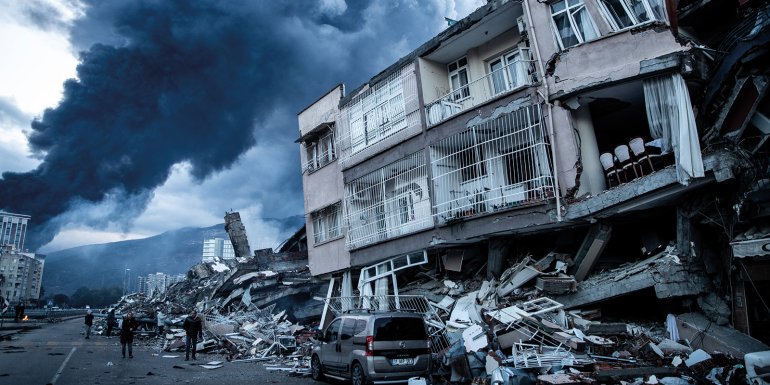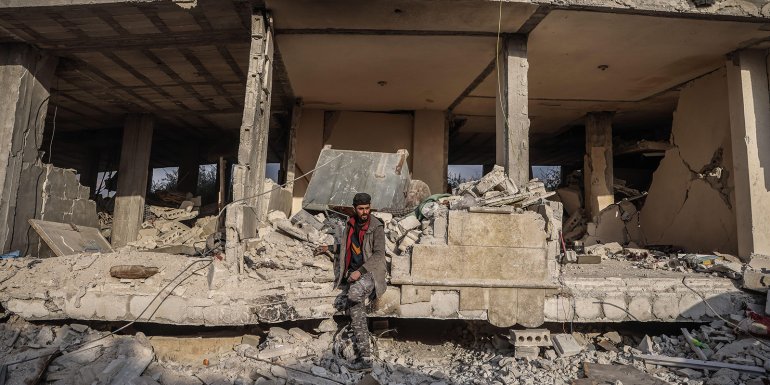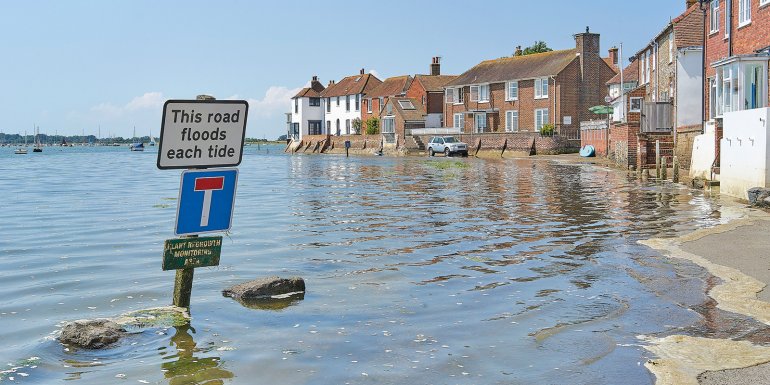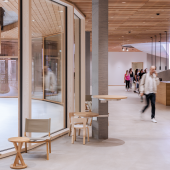Forewarned is forearmed

This year’s earthquakes in Turkey and Syria highlighted how disaster can strike at any minute. Yet catastrophes come in many guises, from global to local. Huw Morris reports on a new mindset to help built environment professionals.
When the first earthquake struck at 4.17am local time on 6 February this year, the seismologists would later register its force at a 7.8 magnitude. This caused most of the damage and deaths across southeast Turkey and northern Syria. To make that catastrophe worse, a second earthquake struck a few hours later. This registered at a 7.6 magnitude.
Together the quakes ravaged an area about the size of Germany, affected around 14 million people in Turkey alone and left about 1.5 million homeless. Infrastructure also took a pounding, with around 1,275km of railway lines severely damaged or destroyed, according to the country’s transport ministry.
Turkish President Recep Tayyip Erdoğan estimates the damage at around $104bn or €96bn. The UN has set the recovery costs for war-torn Syria at $14.8bn. The quakes are the fourth costliest on record, but that’s not the worst of it. The confirmed death toll across both countries stands at more than 67,700. That may well rise as clearance works continue.
Turkey’s government is under severe pressure for not learning lessons from the Izmit earthquake in 1999, a 7.6-magnitude disaster that killed around 18,300 people (although unofficial estimates put the figure much higher). In its aftermath, government officials were denounced for not properly enforcing earthquake-resistant building codes. They are being denounced for making the same mistake a generation later.
The government has been criticised for what has been viewed as a slow response to this year’s disaster and particularly its failure to allocate a significant role to the military. Turkey’s armed forces provided vital rescue and relief in the 1999 disaster and remain the only organisation in the country able to respond rapidly to such events; however, they were absent during the crucial early hours and days in February.
Last October, before the earthquakes struck, the University of Huddersfield Global Disaster Resilience Centre published major research highlighting many of the lessons from disasters and their risks. The study, with project partners the Royal Institution of Chartered Surveyors (RICS) and Sri Lanka’s State Ministry of Rural Roads Development, outlines what built environment professionals in the UK and around the world can do about them.
Sendai Framework for Disaster Risk Reduction 2015-2030
In March 2015, the World Conference for Disaster Risk Reduction took place in Sendai, Japan.
Convened since 1994, the 2015 conference focused on building the resilience of nations and communities to disasters. Sendai saw the agreement of a new international framework to reduce disaster risk. Combined with two other global agreements signed later that year – the UN’s Sustainable Development Goals and the Paris Agreement – Sendai made disaster risk management a central pillar of development, placing it at the heart of sustainability and climate change.
The Sendai Framework aims to guide disaster risk management for numerous hazards across sectors. It urges governments and stakeholders to invest in managing the “risk of small-scale and large-scale, frequent and infrequent, sudden and slow-onset disasters caused by natural or man-made hazards, as well as related environmental, technological and biological hazards and risks”.
The Huddersfield University study argues that uniting the three agreements paved the way to “emphasise cross-cutting themes, developing new knowledge across the different global policy agendas and facilitating support for evidence-based decision-making”. Indeed, the UN Office for Disaster Risk Reduction argues the widespread adoption of the Sendai Framework will substantially reduce disaster risk across a panoply of threats – not only loss of lives and livelihoods, but the danger to cultural, economic, health, social, physical and environmental assets of people, businesses, communities and countries alike.
Assessing and reducing risk
The first step is recognising that the factors driving disaster risk are many, varied and huge. Exploding urbanisation and rapidly changing demographics are long-standing issues. Climate change is getting worse with each passing year. With that comes extreme weather, devastating storms, punishing heatwaves and ferocious wildfires, among other demons. The Covid-19 pandemic also reminded humanity how a health crisis can turn into a disaster as well.
Between 1980 and 2019, disasters and their consequences killed 1.3 million people; traumatised, displaced or affected around 4.4 billion others; and cost $2.97tn, according to the UN Office for Disaster Risk Reduction (UNDRR). In developing countries, it predicts disaster risks could cost up to 19% of annual GDP by 2030.
Since the launch of the Sendai Framework for Disaster Risk Reduction in 2015 (see box above), the global community has faced up to these challenges, but that response has been patchy and non-existent in some places. One answer to the increasing number of catastrophes is Disaster Risk Reduction (DRR) (see box far right).
“Vulnerable areas tend to have the least resources,” says Martin Conlon, now retired but previously Assent Building Control Director. A CABE member and past Chair of RICS’s building control professional group who was one of the Huddersfield University study editors co-writing Rethinking Construction to Reduce Disaster Risks, he notes that some countries are so vast that “it’s very difficult getting the right resources to the right spot” – an issue in the aftermath of the Turkey and Syria earthquakes.
“It’s not as though Turkey was unaware this might happen after the big earthquake in 1999,” he says. “What tends to happen is that complacency sets in – yes, they know about it now and they’re worried about the future, but in five years’ time they’ll have forgotten about it. People take their eye off the ball, then a major disaster comes up. The governance of a country with its framework, legislation and building codes are important and sets the tone all the way down the line.”
He describes DRR as “a change in mindset” that does not only apply to third-world countries, although they are disproportionately affected by natural disasters. UK built environment professionals should take heed as well.
“In this country we’re seeing the impact of climate change and weather extremes. It’s not just flooding – we’re getting variations in temperature as seen with last summer’s wildfires. We’re also getting stronger winds, so we’ve got to look at whether our buildings are equipped to deal with violent extremes.
“It’s a case of looking at the impact of the natural world as climate change is evolving. What are the preventative measures, and what’s their value in preserving people’s lives, as well as their social and economic benefits? If you lose a school, what’s the impact on the local area of children not learning? That has a long-term effect.”
Conlon acknowledges that DRR has been below the radar for many built environment professionals, but now must be integrated across the construction, infrastructure, land and real estate sectors. How does the concept fit in with building regulations in the UK?
“We are at a crossroads,” he says. “The Grenfell Tower fire has had a major impact on fire resistance and on our understanding, regulation and governance, but the impact of climate change on our regulations has not been considered.”

Proactive rather than reactive
Conlon continues: “Historically, our regulatory system has been stable door legislation – a disaster happens, we look at what caused it and how can we prevent it from happening again, and we close that stable door – only to find a hole appearing elsewhere. It’s a bit like whack-a-mole.”
The UK’s regulatory system needs a “complete rethink”, he adds, pointing to parts of the country such as Devon and Cornwall, which still have hosepipe bans from the heatwaves in 2022 despite March 2023 being one of wettest months on record. In short, the system needs climate change-proofing.
“Some parts of the country have more water than they can cope with, while others have water shortages. How can we design a regulatory environment to accommodate that?
“We need to look much more widely at climate change and not just at major headlines like a building collapsing or a big fire. We need to look at the more mundane things that impact us in the future and how we can mitigate it.”
The formal linking of the Sendai Framework with the UN’s Sustainable Development Goals and the Paris Agreement is moving DRR from a technical discipline to one of sustainable development. Indeed, the very notion of sustainability is undergoing an evolution.
“The definition of sustainability is changing,” says Conlon. “In the early days, it meant building green, but now we’re saying that we need to build for the future. If you have a building that lasts, it’s far more sustainable than one we have to discount after time.”
This means that DRR thinking should be applied to conventional challenges as much as overriding crises. In short, think local as much as global. One of the best examples is school fires, an issue highlighted by Zurich Munich research in 2020. This revealed 480 primary and secondary schools in England suffered fire incidents in 2019 – an average of 40 incidents each month.
More than 15,000m² of school spaces were burnt down by fires in 2019. Firefighters responded to almost 2,000 school fires in England alone in the previous three years, with arson, malfunctioning appliances or equipment, faulty electrics and kitchen blazes the chief causes. The research noted that larger fires in schools cost £2.8m on average to repair and can go as high as £20m. Less easy to quantify was the impact on children – nearly 20,000 were affected, with many displaced from their usual school buildings.
“School fires tend to occur when buildings are empty,” says Conlon. “If the building is not built correctly, we’ve lost it and have to rebuild. That has an impact on construction, materials and resources. But equally, as it’s a school, it impacts the social and economic ability of the community. The lives of children, teachers and parents are disrupted. Sustainability means it’s much better that we build a structure that lasts and can withstand a disaster.”
Disaster Risk Reduction
Prevention is the key force “driving all policies, strategies and practices to avoid or limit the adverse effects of hazards”, according to the Huddersfield University study. DRR operates in two stages – pre- and post-disaster – but the bulk of it must be mainly before a disaster can occur.
The concept raises crucial questions. Can the built environment withstand threats of disaster, whether they are apparent or emerging? Can it handle the disruptions caused by a disaster? Can it bounce back after those disruptions?
DRR has four dimensions:
- technical: the capability of physical systems – including all their subcomponents and infrastructure – to deliver desired results
- organisational: the capacity of organisations and institutions in charge of essential facilities to carry out “critical disaster-related functions” effectively and quickly
- social: how to mitigate the impact of disaster on communities and areas; an
- economic: reducing the direct and indirect economic losses from disasters.
For Conlon, these four dimensions raise a series of further interconnected questions that every built environment professional should consider.
“Do we not only have the technical expertise to understand the impact of disasters, but also the technical expertise to be able to build better and create a better environment?” he asks. “Does the area have the institutional capacity to carry out critical disaster-related functions? The recent earthquake in Turkey is a good example of the organisational element, where there was a lack of ability to organise, get into the area and deal with it.
“These four dimensions are important, as well as looking at the vulnerability of an area. What is the physical situation? How vulnerable is it to disaster? What’s the infrastructure like and will the education system be able to cope with it?”

Barriers to DRR
The Huddersfield University study warns that “the components of a low-quality built environment can be a disaster waiting to happen”. Yet it also highlights several important barriers towards integrating DRR into construction.
Firstly, a lack of regulatory frameworks. A lack of capacity and co-ordination at a national level, incompatibility of building codes and a lack of enforcement of rules and regulations at all levels are the main barriers to incorporating disaster risk into the construction sector.
Secondly, unplanned cities and urbanisation. These lead to significant global ecological, economic and social risks. They then exacerbate severe issues such as climate change, disasters and environmental degradation.
Thirdly, a lack of understanding system risks. Covid-19 posed a significant challenge due to the widespread lack of understanding and experience in reacting to a pandemic. Natural disasters occurring amid biological hazards create double emergencies.
Fourthly, institutional arrangements. Although various built environment disciplines are interdependent, misunderstandings caused by silo thinking and professional jargon can easily lead to poor communication between stakeholders. This also impedes the sharing of good practice and resources, and even poor leadership and teamwork. People and communities also struggle to understand what professionals are trying to achieve.
What the built environment professions should do
The Huddersfield University study urges built environment professional bodies to continuously update the competencies, accreditation or services needed to identify and verify expertise in weak or emerging new areas of practice.
Without such recognition, professionals are unlikely to value education and training in these skills, it warns. Disaster resilience should also be part of professional and ethical standards.
While the field of disaster management is expanding, there is still a lack of built environment professionals with the right skills and knowledge to support the building of resilience. Networks of such key professionals should be established, the study argues.
Specialists in built environment research, education and training must work with policy-makers, standards bodies and practitioners to identify gaps in knowledge and then plug them. Multi-stakeholder groups will need to work together to design and deliver that expertise and training.
The study points out that the pace of scientific discoveries demands that education and training programmes are research-linked to ensure that what is being taught is consistent with state-of-the-art practice.
Fifthly, a scarcity of resources is one of the main reasons for the under-investment in disaster resilience. A considerable level of economies of scale is needed for an infrastructure project to become financially viable. In the context of developing economies, such barriers are further amplified by their reduced ability to pay for infrastructure, the inherent risks that are perceived in these types of areas, inadequate data, poor communication and weak regulation.
Finally, a lack of understanding by clients and property owners of what each profession does and how they relate to one another. Overlapping roles and expertise mean that while some skills are specific to particular professions, others are shared – with project management as a prime example.
Clients and property owners also do not understand or lack information for them to employ built environment practitioners in DRR. Whether particular professionals are likely to have the relevant expertise and experience is another issue, as is uncertainty as to how long they may need to be employed and the associated costs. Different professions can also vary considerably around the world, both in name and specific areas of expertise.
For Conlon, it all starts with acceptance of the problem. “If I don’t know it’s a problem, I’m not going to do something about it. Our political controllers have other things to worry about with day-to-day problems. There needs to be a framework to acknowledge what the issues are.
“We then need to identify the problem for the area and that there is no one-size-fits-all solution. What’s good for the UK might not be good for Turkey or any other country. On top of this, the regulatory framework is crucial. This means acknowledging that good planning is required for buildings and communities, not just in the building standards but in their locations.”
The cost of natural catastrophes in 2022
Global economic losses from natural catastrophes were $313bn in 2022 – the fifth costliest year in history – according to an analysis by Aon.
The professional services consultancy’s research reveals last year’s losses were 4% above the 21st-century average so far. However, losses from natural disasters covered by the global insurance industry were $132bn. This was 57% above the average for this century.
Overall, this left a protection gap of uninsured losses of 58%. This gap was one of the lowest on record, despite at least 421 individual events, including floods and hurricanes, in comparison to an average of 396 since the turn of the century. This is largely because many of the most expensive disasters last year occurred in the US and Europe, which have mature insurance markets, with fewer catastrophes in less protected regions.
Aon blames 5% of the global insured losses on Hurricane Ian, which devastated parts of Florida last September. This led to insured damages of up to $55bn – the second costliest natural disaster for insurers on record, only surpassed by Hurricane Katrina, which devastated New Orleans in 2005 and led to insured damages of $99bn with price inflation. Hurricane Ian’s total economic losses are estimated at $95bn.
Around 31,300 people died in natural disasters last year, of which around two-thirds were linked to severe heatwaves in Europe.

Moreover, DRR thinking tunes into an overlooked part of the human psyche: the drive to leave a legacy. “Everyone who is involved in the profession is building for the future, not building for now. As we develop buildings for the next generation, the hope is we leave behind a legacy of good building standards that people are proud of. When I worked in building control, I wanted to make sure there were good building standards in care homes because that’s where I’m going to end up.
“If you look at the Victorian town halls of Manchester, Leeds and Liverpool, our forebears built for the future but also to show off. There was a certain amount of pride.
“We need to get that pride back into what we do for the future.”
Rethinking Construction to Reduce Disaster Risks is available at bit.ly/GDRC_buildresilience







